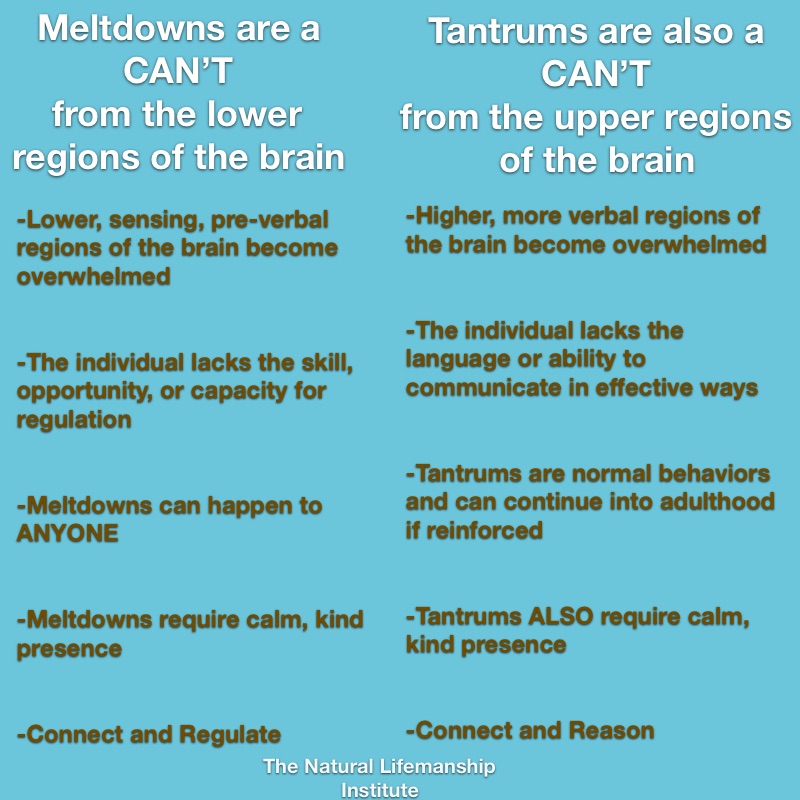By Kate Naylor & Bettina Shultz-Jobe
A couple weeks ago, we shared this meme created by Our Mama Village about tantrums. After several long discussions on that Facebook post, we here at NaturalLifemanship felt we should write on the topic to help clarify the message we intended to demonstrate with the meme we posted. Additionally, it seems incredibly important to many parents and professionals that there be conversation on this topic – what is a tantrum and what is a meltdown….what do they have in common and how are they different? It is important to note that we are discussing these words as constructs – by definition the difference is minimal.
Follow the Facebook discussion here.
Let us begin by saying that we recognize there are many parents and professionals out there who care for children who experience challenging behaviors that others may not understand. We see that there is a need to educate the general population of the differences between behaviors.
At Natural Lifemanship we DO believe:
- that meltdowns are a product of overwhelm for ANY child
- that meltdowns should be treated with empathy and calm, kind presence
- that meltdowns are NOT an example of poor behavior in children or poor parenting practices
- Meltdowns occur due to a lack of skills to be able to regulate or handle emotional upset (depending on the child, the skills will come with age and learning, for other children these skills will be more difficult to acquire)
And at Natural Lifemanship, we ALSO believe:
- that tantrums are a typical part of a child’s development of proper communication
- Tantrums do not mean parents have done a poor job parenting
- Tantrums demonstrate a lack of skill to communicate in a relationally appropriate way (some children will acquire this skill with time and practice, some will learn tantrums are their most effective way to communicate and continue using them)
- Tantrums are not an example of willful manipulation with malicious intent – they are a behavior that all children attempt to get their needs met. We approach tantrums with the same empathy and kind presence as we do meltdowns. (depending on the child, the skills will come with age and learning, for other children these skills will be more difficult to acquire)
So what’s the difference?
A meltdown demonstrates a CAN’T from the lower regions of the brain. When a child is experiencing more sensory or emotional input than he or she can handle their nervous system becomes overwhelmed and sometimes this leads to intense reactions like strong crying, falling on the floor, yelling, physical aggression, self-harm, and attempts at self soothing like rocking. This is an example of the sensorial, motor, and emotional regions of the brain being so overwhelmed that control over these regions is temporarily lost. The way we adults respond to this matters. We respond with bottom-up regulation – caring, calm presence, deep breaths of our own, and if possible, rhythm that the child does not have produce herself (holding her, rocking her, tapping a rhythm she can hear, etc.). This is not a moment for teaching or lots of questions (this requires upper brain regions that are “offline” in that moment). Once the child is calm again, we can connect and teach skills for handling overwhelm or communicating overwhelm. A child’s ability to learn these skills is always there, but their progress will vary based on their development, capacity, and the predictability of the interactions between the child and the adults around her.
A tantrum is also a CAN’T but from the upper regions of the brain. Imagine a typical small child in a typical day. How frequently is this child in control of their lives? Not very frequently, at all. They hear the word “no” throughout the day, they don’t have a strong enough vocabulary to communicate clearly their needs and wants, and they often are not allowed to do or have what they want because of an adult stopping them (for a multitude of reasons). So, when a child is not developmentally to the point where their brain and bodies can communicate well, they feel controlled, and they are desperately searching for a sense of their own control – tantrums follow. When a child hears “no” for the hundredth time, when they want something they cannot have and experience disappointment, when they try to communicate an idea and we adults don’t listen or don’t understand – the child experiences overwhelm in their thinking and feeling and in turn has a strong reaction that may include similar behaviors to a meltdown. In this situation we often can respond in a more “top-down” approach, using words and reasoning that speak to the upper regions of the brain, BUT we ALSO need to regulate and soothe ALL the regions of the brain for the child to truly calm down. This means we need to be as calm and kind in our presence as we are during a meltdown. We believe there is an important distinction between a tantrum being seen as difficulty with communication versus willful manipulation. One perspective attempts to understand the behavior and address the root problem, the other is a blaming stance that does not attempt to address the difficulty underneath. These two perspectives often lead adults to two different kinds of responses. THIS is the issue we intended to address with the meme we posted from Our Mama Village. We DO not believe tantrums to be malicious or willful – brain science tells us it is a lack of communication skills, a lack of development, that leads to tantrums.

Of course, we can reinforce a tantrum by giving in to the request and teach a child that tantrums are effective – so we encourage parents to be firm in setting and maintaining an appropriate limit during a tantrum…but we can do that with kindness and empathy.
As a quick side note, we believe that adults can also have tantrums and meltdowns. Many adults also lack the skills to communicate their needs when they feel powerless, overwhelmed, etc. The experience and embodiment of trauma – and the resulting mental health diagnoses – often result in an inability to regulate and handle overwhelm or emotional upset. This is very important to understand if you do therapy with adults, especially if you do equine assisted psychotherapy (EAP) with adults -dysregulation and regression are often a part of the process – how we handle this is so important. We also believe that horses and other animals have tantrums (as the upper regions of their brains develop more) and meltdowns. How we handle tantrums and meltdowns with horses and other animals, especially when doing EAP or EAL is such an important part of the process. It is important that we model how to address the need underneath the behavior in our sessions. Tantrums and meltdowns happen with adults and animals for the same reasons stated above, and should be handled the same way – with empathy and a kind presence. Remember, a good principle is a good principle regardless of where it is applied.



Recent Comments